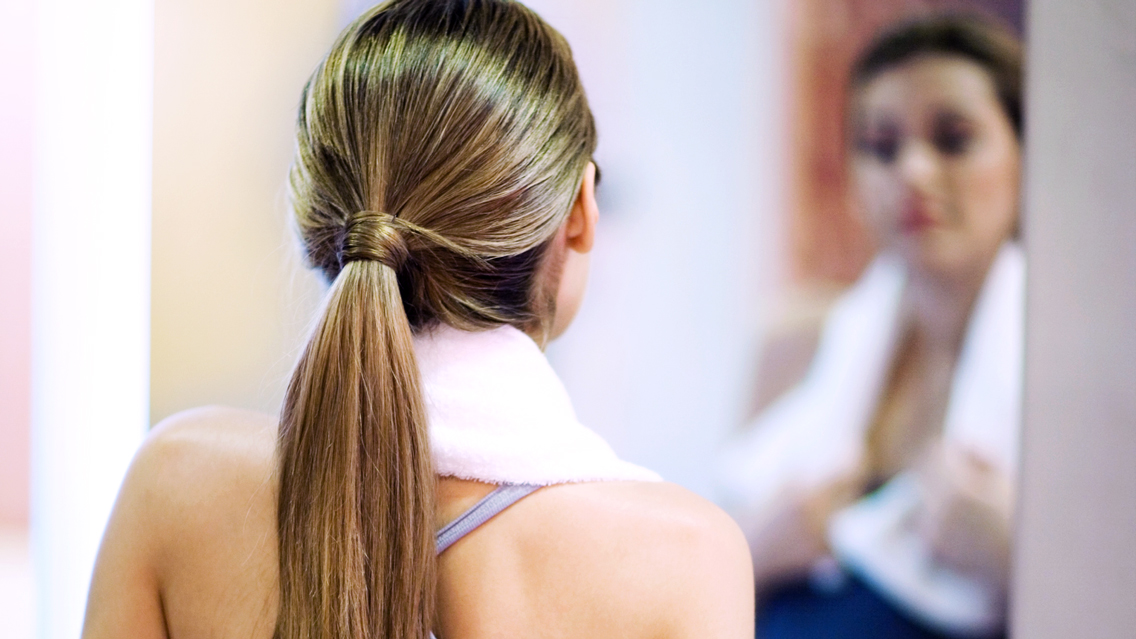What is a “good body”?
Like it or not, the media’s definition is the one a great many people take for granted: For women, it’s slender, flat-bellied and leggy — while still being hourglass shaped. For men, it’s sculpted arms, broad shoulders and chiseled abs — with a perfect V-shaped torso.
Unless you live in a cave, you can’t avoid these conventional ideals. We’re bombarded by them on TV shows, commercials and billboards, and in movies, magazines and newspapers.
Listening to all of the little voices telling us the way we should look — including the voices inside our own heads — has warped our priorities. According to a 2009 Oxygen Media survey of more than 2,000 adults, nearly 25 percent of women ages 18 to 34 would rather win America’s Next Top Model than the Nobel Peace Prize. A 2011 survey of more than 26,000 moms conducted by Today.com and Parenting.com found that 44 percent would rather be 15 pounds thinner than add 15 points to their child’s IQ.
“Attractiveness is socially rewarded, from being picked for a team in gym class to finding romantic partners, getting a job or being promoted,” says Tara Cousineau, PhD, a clinical psychologist in Boston, an expert on teen health and founder of BodiMojo.com, a health and social networking platform for adolescents that combats problems related to poor body image.
Although women may be more prone to body-image problems, men are by no means immune to them, Cousineau notes. “There has been a silent and unsettling trend that’s created pressure for guys to buff up,” she says. “Just like Barbie is the quintessential unrealistic token of female beauty, boys’ action figures have morphed into ballooned characters with roils of muscles — a far cry from the original Ken or G.I. Joe.”
While neither Barbie nor G.I. Joe represents a healthy body-image role model, the average American doesn’t either. According to the Centers for Disease Control and Prevention’s National Center for Health Statistics, American adults weigh nearly 25 pounds more than they did in 1960, and the number of overweight and obese adults is growing every year. This means we’re getting accustomed to a new “normal” that’s far heavier than what’s healthy for most.
Given this context of extremes, how are any of us supposed to know what our own “ideal body” really is? How much should we care (or obsess) about pursuing any ideal — versus making the best of the bodies we have now? And how can we begin developing a healthier, more realistic and empowering perception of our own bodies — one that supports us becoming as healthy and fit as we want to be?
A Sizeable Challenge
As with most journeys toward health and healing, the first step is acknowledging there’s a problem. And in this case, the problem begins with a distorted, poorly informed sense of our own body’s shape and size.
It turns out that most of us — both women and men — incorrectly perceive our weight, says Will Courtenay, PhD, LCSW, author of Dying to Be Men.
While women often think they’re heavier and bigger than they actually are, men fall into two different camps of body-weight distortion.
“On the one hand, we have normal-weight men and boys who think they’re underweight,” says Courtenay. They often feel pressure, he says, to bulk up and be more masculine, believing this will make them more physically attractive. “But if you think you’re building your body to attract women, think again,” Courtenay notes. “Research tells us the body women like is about 15 to 20 pounds less muscular than what men think women like.”
Then, in the other camp are overweight men who think their weight is just fine. “This is true for nearly half of overweight men,” says Courtenay. They might be smaller than some of their friends or colleagues, he notes, but that doesn’t mean they’re at an ideal, healthy weight: “These guys are being influenced by the normalizing effect of the obesity epidemic.”
Basically, there are two totally different standards of “normal,” and neither of them is particularly healthy. In fact, the conflicting representations of “ideal” are literally making Americans sick.
Basically, there are two totally different standards of “normal,” and neither of them is particularly healthy. In fact, the conflicting representations of “ideal” are literally making Americans sick, says Robert Hedaya, MD, DFAPA, founder of the National Center for Whole Psychiatry, which examines hormonal, nutritional, immune function, detoxification, genetics and gut influences on psychiatric problems. Body-image-related anxiety and digestive disorders are on the rise, he notes. A large-scale 2011 survey conducted by Psychology Today indicates most women and about half of men are dissatisfied with their appearance. For some, that dissatisfaction turns into body dysmorphia, a partially psychological disorder in which a person is excessively concerned about his or her physical features, Hedaya says.
Many are turning to cosmetic surgery for a quick fix. More than half of Americans now view plastic surgery as a reasonable option, according to the American Society for Aesthetic Plastic Surgery. And the number of people going under the knife is rising (up 9 percent in 2010).
But the effects of such surgeries don’t always resolve body-image issues, and in some cases they can make matters worse, setting individuals on a never-ending quest for perfection and self-confidence that no amount of nip-and-tuck can satisfy.
Cosmetic surgery can become a misguided strategy for coping with feelings of self-loathing or low self-worth, notes Courtenay. “If you’re overly self-critical and self-doubting by nature, a scalpel won’t solve the problem,” he says.
The same goes for extreme dieting. The National Association of Anorexia Nervosa and Associated Disorders estimates that up to 24 million people of all ages and both genders suffer from eating disorders. But many go unnoticed because dieting is increasingly considered “normal” in our weight-obsessed culture. There’s a multibillion-dollar weight-loss industry that’s only adding to our body-image distortion, says Courtenay. “They’re profiting off your insecurity about your body,” he suggests. To improve your body image, you have to learn to override the deception that comes from within and without.
How to Overcome Body Envy
Whether you’re looking at magazines, television or movies, if you consume media, you’re going to see a lot of beautiful, exceptionally well-proportioned, carefully honed and professionally perfected bodies — bodies chosen and groomed for these starring roles precisely because they are extraordinary.
According to the Association of Model Agents, the average female fashion model is 5 feet 8 inches or taller and measures 34-24-34 (bust-waist-hips). Male models are typically 6 feet or taller with a 40-inch chest and chiseled body.
For most of us — about 99 percent of us — those measurements are flat-out unattainable, simply by virtue of our genetics and skeletal frames.
For most of us — about 99 percent of us — those measurements are flat-out unattainable, simply by virtue of our genetics and skeletal frames. But the truth is, even the supermodels and celebrities you see in these pictures aren’t quite as perfect as they look. They appear the way they do, at least in part, because they are professionally lit, professionally made up, professionally posed, and — by the time you see their photographs, professionally digitally retouched.
Take a look at the aggressive Photoshop-powered carving, shading, shrinking, stretching and airbrushing that commonly occurs in the photo studio and you’ll understand better why no real person should expect to look as flawless as these poster-ready celebs do. These pictures are pure fantasy — even for the genetically blessed individuals they portray.
Even with good genetics, getting and staying in the kind of shape most movie stars and models have to maintain (particularly while they are on the job) takes serious work and investment.
“Celebrity life is not real life,” says Elizabeth Lombardo, PhD, MS, PT, psychologist, physical therapist and author of A Happy You: Your Ultimate Prescription for Happiness. “Celebrities have numerous support people whose full-time job is to make them look good, from daily personal trainers to private chefs and wardrobe stylists.”
“Celebrities are notorious for going on TV and saying, ‘Oh, I do a little cardio a couple times a week,’ or ‘I do yoga three times a week,’” Ziff says. “But the reality is, many exercise for hours a day. The average person who works, takes care of a family and a home could never put in the time that many celebrities do.”
Celebrities have also been known to bend the truth about how much time they spend working out, says Sherri Ziff, PCC, a certified life coach and founder of Rock Your Life Coaching in Hollywood, Calif. “Celebrities are notorious for going on TV and saying, ‘Oh, I do a little cardio a couple times a week,’ or ‘I do yoga three times a week,’” Ziff says. “But the reality is, many exercise for hours a day. The average person who works, takes care of a family and a home could never put in the time that many celebrities do.”
For all these reasons and more, idolizing celebrities and models can be destructive to your body image. Seeking out healthy, realistic role models, on the other hand, can boost your confidence and motivation, notes Lombardo.
So admiring Michelle Obama’s biceps or Pippa Middleton’s glutes isn’t necessarily a bad thing — as long as you recognize that you are not genetically or biologically identical to Michelle Obama or Pippa Middleton, so your body will never look exactly like theirs.
There a fine line between beautiful aspiration and body-image affliction, notes Hedaya. “If you find yourself thinking, ‘If only I could look like him/her, then I could be happy/successful/powerful,’ it’s unhealthy,” he says. “But if you find a role model who reinforces your own quest for a healthy lifestyle (moderate exercise, adequate sleep, healthy eating), then seeking to be more like that person can be OK.”
How to Reframe Your Thinking About Your Body
Neuroscience has taught us that the human brain continues to develop, meaning that each of us can revise the way we respond to stimuli and reframe our attitudes over time. “Basically, you have the power to override what you see in media and create your own image of what’s beautiful,” explains Adam Farrah, an IKFF Certified Kettlebell Teacher, CrossFit trainer, Paleo diet coach and cofounder of the popular “Strong Is the New Skinny” social-media campaign.
“We’re trying to shift power back to consumers and away from conventional advertisers and other image makers,” Farrah says. To do this, Farrah and his followers are attempting to flood social media with healthy examples of real, fit bodies of all shapes and sizes.
“The most important thing is to start focusing on health and fitness rather than aesthetics.”
The more you expose yourself to a diversity of healthy, positive body images, he says, the more your thinking will be reframed for the better.
“The most important thing is to start focusing on health and fitness rather than aesthetics,” he says. “That gets you away from the mirror and more focused on what your body can do.” From there, he notes, the only “good body” definition that matters is yours.
How to Reframe Negative Self-Talk Around Body Image
Want a fast way to improve your self-image? Replace demoralizing self-criticism with more no-nonsense statements that reflect positive appreciation for your body — and your present reality. Whether you speak your affirmations silently or out loud, they can help you transform your self-perception over time.
| Negative: “Ugh, I’m getting wrinkles. I look old.” | No-nonsense: “My face is appealing and expressive. It reflects my life experience, personality and authentic emotions.” |
| Negative: “My chest is too [small/big/droopy/uneven].” | No-nonsense: “Everyone’s shape and build are different. My breasts are healthy, beautiful and unique to me.” |
| Negative: “My hips are too wide.” | No-nonsense: “My hips are feminine and curvy. They’re one of my body’s great sources of strength and balance.” |
| Negative: “I hate my thighs.” | No-nonsense: “I’m grateful for my strong quads and hamstrings.” |
| Negative: “Ugh, this cellulite is disgusting.“ | No-nonsense: “Cellulite is no big deal. Why let a few dimples detract from my self-confidence?” |
| Negative: “I am not going to be seen at the gym until I lose 10 pounds.” | No-nonsense: “I am committed to taking good care of myself, even on days I feel down.” |
| Negative: “My pecs look puny next to that guy’s.” | No-nonsense: “I’m more focused on my career and family than on pumping iron right now. My body reflects my current choices and priorities. |
| Negative: “All this working out is pointless. I still don’t have six-pack abs.” | No-nonsense: “I enjoy taking good care of myself. I am grateful that I have a fit body, and that my abs don’t define who I am.” |
| Negative: “My legs are way too scrawny — I can’t ever wear shorts.” | No-nonsense: “I can develop my leg muscles with exercise if I want to. But these are the legs I was born with, and they get me around just fine. I’ll wear whatever’s most comfortable for my chosen activities.” |
| Negative: “Going bald is my worst nightmare.” | No-nonsense: “A bald head is sexy when worn with confidence.” |
Connect With Your Self-Confidence
Nurturing self-acceptance builds confidence and self-esteem, which in turn makes healthy choices easier and more rewarding.
- “Make health and fitness, rather than bodily aesthetics, your goal,” suggests Adam Farrah, cofounder of the popular “Strong Is the New Skinny” social-media campaign. Instead of obsessing about six-pack abs, focus on lifting heavier weights, running a 5K, or getting your cholesterol numbers down.
- When negativity creeps in, shift your perception. Journaling or talking with a wise friend can help you challenge the kind of self-critical thinking that makes your current dissatisfaction with one part of your body seem like a vast, insurmountable problem, says Eve Eliot, diplomate of the American Psychotherapy Association, yoga instructor and author of Insatiable.
- Appreciate your body for what it is capable of today, and strive for better fitness and strength in the future, Farrah says. Being less than perfectly happy with your body right now doesn’t mean you have to put all your plans for self-care and fitness-building on the back burner.
- List your successes, big and small. Being mindful of personal victory, even if it’s just showing up at the gym for the first time or getting that walk in after work, will give you more confidence to keep going, says Eliot.
- Ooze confidence, even if you don’t feel it yet. Studies show that smiling and projecting a positive vibe (even if it’s a bit of an act) can affect your brain chemistry over time, and may even boost your mood in the moment.
- Even if you’re not feeling capable of loving your body just now, commit to respecting it. Stand still for a moment, close your eyes, and send your body a message of appreciation for hanging in there with you, day in and day out. As long as you’re alive, you’ve got your body to thank for every heartbeat, every breath, every step — each and every day.
How Healthy Is Your Body Image?
When you’re on good terms with your body, it shows. Here are some signs you’re on the right track:
- When someone compliments you on your appearance or fitness, you’re gracious and accept the compliment as authentic.
- You prefer to wear clothes that highlight your form rather than hide it.
- It is not hard to find an outfit in which you feel comfortable and attractive.
- You rarely compare yourself with others. You recognize that you are unique.
- You can admire another person’s physique without silently criticizing or judging your own.
- When you pass by a mirror or storefront window, you don’t stop and nitpick your appearance; you might even give yourself an approving nod.
- You can name several parts of your body that you genuinely like and appreciate.
- If you put on (or lose) a little weight, you can note it matter-of-factly, without undue anxiety or stubborn denial.
- You are more focused on optimizing your health, fitness and confidence than on achieving a particular weight or “look.”
This article has been updated. It originally appeared as “Build a Better Body Images” in the April 2012 issue of Experience Life.




This Post Has 0 Comments